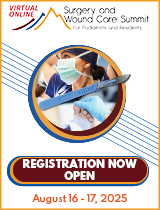|
|
|

|
Search
06/27/2025 Bret M. Ribotsky, DPM
Student Enrollment Should be Two-Sided
I am writing to express my concerns regarding the
increasing requests for individual practitioners
to dedicate significant time to marketing and
college visits aimed at increasing recruitment
into podiatric medical schools. While I understand
the importance of maintaining strong enrollment in
our profession’s educational institutions, I find
the current approach to be fundamentally one-
sided. These requests ask practicing podiatrists
to invest considerable time and effort in
activities that primarily benefit private
educational institutions financially through
increased student enrollment.
What troubles me the most is the apparent
unwillingness of these schools to reciprocate with
meaningful benefits for the general membership of
practicing podiatrists. If we are truly expected
to function as a collaborative “village” where
everyone works together for the betterment of the
profession, then this relationship should be
mutually beneficial.
As a constructive suggestion, I propose that
schools demonstrate their commitment to the
broader podiatric community by offering valuable
resources to practicing physicians. For instance,
allowing general podiatrists to access refresher
courses—such as biomechanics classes—at no cost
would provide tangible value to those being asked
to volunteer their time for recruitment efforts.
The current model essentially asks practicing
physicians to serve as unpaid marketing
representatives for private businesses without
receiving any professional development
opportunities or other forms of remuneration in
return. This approach fails to recognize the value
of practitioners’ time and expertise while
expecting them to contribute to the financial
success of these institutions.
I believe that for any recruitment collaboration
to be successful and sustainable, it must be
structured as a genuine partnership that provides
mutual benefits. Schools that wish to engage
practicing podiatrists in recruitment activities
should be prepared to offer meaningful value in
return, whether through continuing education
opportunities, research collaborations, or other
professional development resources.
I hope this perspective will be considered as we
move forward with discussions about how best to
support both the educational institutions and the
practicing members of our profession.
Bret M. Ribotsky, DPM, Ft. Lauderdale, FL
Other messages in this thread:
06/30/2025 Douglas Richie, DPM
Student Enrollment Should be Two-Sided (Bret M. Ribotsky, DPM)
I read with great disappointment Dr. Ribotsky’s
characterization of the current student
recruitment campaign at the schools of podiatric
medicine across the United States. Dr. Ribotsky
described the role of podiatrists in mentoring
prospective students as “unpaid marketing
representatives for private businesses, without
receiving any professional development
opportunities or other forms of remuneration in
return.” He proposes that podiatric physicians who
participate in a recruitment and mentoring program
for pre-medical students “invest considerable time
and effort in activities that primarily benefit
private educational institutions financially.”
I believe that Dr. Ribotsky has confused the
current recruiting campaign of podiatric medical
schools with his own previous efforts to recruit
vendors to support his for-profit seminars. His
philosophy of the need for “mutual benefits” for
all parties may have been a strategy to get
commercial companies to invest in his seminars,
but this has little relevance to the current
podiatry student recruitment campaign. His
characterization that student recruitment
“primarily benefits private educational
institutions financially” misses the purposeful
value of this campaign and the critical need to
increase the number of qualified applicants to
podiatric medical schools.
All of the schools of podiatric medicine in the
United States are non-profit institutions. The
need to boost applicants is not bent on profits
but instead is critically important to the
survival of the schools and our profession. If
the trend in decline in numbers of qualified
applicants continues, all the podiatric medical
schools in this country could close and our DPM
degree will become obsolete.
Contrary to what Dr. Ribotsky asserts, practicing
DPM’s are being encouraged to help contribute to
the student recruitment process in very simple and
time efficient ways. Whether engaging in
conversation with high school or college students
or allowing these aspiring people to shadow in
podiatric practice, the time commitment is minimal
and potentially rewarding. Further participation
at local university career fairs or pre-med clubs
may require a few hours of volunteer time from a
podiatric physician. How many podiatrists
already willingly volunteer to participate in
community health screenings or running events?
Beyond supporting a recruitment campaign many of
us regularly fulfill an even more important
obligation to the schools of podiatric medicine
which provided us a rich learning experience and a
wonderful career. Across the country, thousands of
DPMS willingly contribute financially to their
alma mater podiatry schools. The voluntary
contributions of grateful alumni are essential to
the financial well-being of all these non-profit
institutions. We make these contributions
willingly without demand for payback or “mutual
benefits.” Incidentally, most of the podiatry
schools provide ongoing professional development
opportunities for their contributing alumnae,
often at considerable discount.
In a recent LinkedIn post, my esteemed colleague,
Luke Cicchinelli recently quoted Denzel Washington
who said “First part of your life, you Learn, Second
part of your life, you Earn, third part of your
life, you Return.” I hope that my colleagues will
see the wisdom of this message and seize the
opportunity to give back to our schools of
podiatric medicine---with no strings attached.
Douglas Richie, DPM
Member, Board of Regents at Samuel Merritt
University, College of Podiatric Medicine
|
| |

|
|







